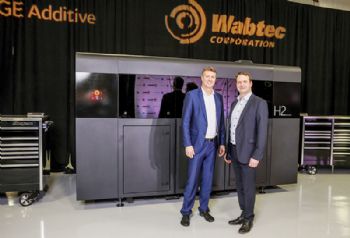
Wabtec Corporation — a global provider of equipment, systems, digital solutions and value-added services for freight and transit rail — has bought a second GE Additive H2 binder jet printer to “accelerate its growing additive strategy”.
Philip Moslener (global director of WabtecOne Platform and Applied Innovation) said: “Additive is one of the key technology pillars for our company and central in our efforts to drive innovation.
“This binder jet machine will help us to design and produce reliable low-cost components for our current and developmental engine, locomotive, transit and mining programmes.”
So far, the company has identified that additive technologies could be used in the production of up to 250 components for its product lines by 2025.
Wabtec’s (
www.wabetec.com)first H2 machine is currently located at GE Additive’s labs in Cincinnati, where teams from Wabtec are working on technology development before the machine is relocated to the company’s Grove City (Pennsylvania) facility later this year.
GE Additive has been working with a number of strategic partners and key customers to quickly ‘scale up’ its binder jet technology — first into pilot lines, then into complete industrialised factory solutions, which are expected to be commercially available in early 2021.
Metal binder jetting is a type of additive manufacturing where a print head moves across a bed of metal powder and selectively deposits a liquid binding agent in the shape of the section to be built, bonding these areas together to form ‘green’ parts one layer at a time.
When the build is complete, the ‘green’ parts are removed from the build box and sent to a sintering oven, which removes the binder and fuses the metal powder into solid metal parts.
The material currently used for producing parts is stainless steel 316, but other materials are under development, including low-carbon steels.